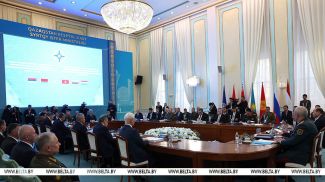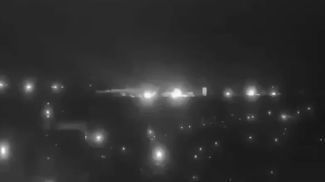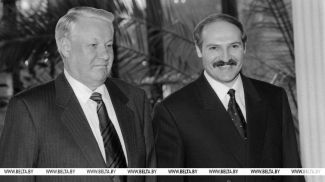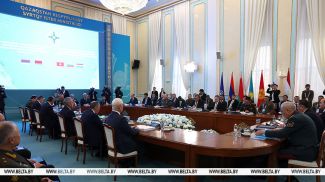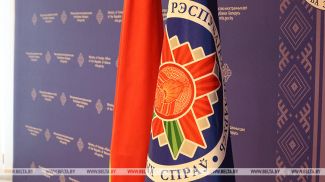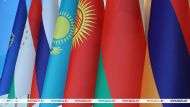MINSK, 9 May (BelTA) – Victory Day is celebrated in the Republic of Belarus today. It is a sacred holiday, a tribute of remembrance, deep respect and gratitude to the Soviet soldiers, homefront workers, and underground resistance fighters, to all those, who made the victory possible.
On 9 May 1945 the Soviet people won the Great Patriotic War that had lasted for 1,418 days and nights and started in the Belarusian land on 22 June 1941.
The country experienced a blow of unprecedented force. In the first days of the war enemy aircraft bombed railway junctions, airfields, Brest, Grodno, Volkovysk, Baranovichi, and other Belarusian cities. Border guards were the first to face the enemy. No outpost surrendered to the enemy or left the post without an order. The defenders of the Brest Fortress, Minsk and Mogilev put up a fierce resistance. The Soviet multiple-launch rocket systems (MLRS) Katyusha were first used against the enemy near Orsha on 14 July. The strong resistance that the enemy faced in battles in Belarus derailed the German plans of a rapid offensive against Moscow.
However, despite courage and heroism the territory of Belarus was occupied by the Germans by the beginning of September 1941. In Belarus the enemy faced resistance unprecedented in scale and persistence. The partisan movement, which over the years of the Great Patriotic War involved more than 374,000 partisans, was the main form of the nationwide fight. The underground resistance movement numbered over 70,000 members. Representatives of various peoples of the Soviet Union and anti-fascists from European countries fought alongside Belarusians against the enemy as part of partisan units.
During the war there were about 30 partisan zones which the Germans failed to occupy. For example, the Klichev partisan zone was controlled by the partisans from March 1942. By the beginning of 1944 it was 3,000 km2 big. More than 70,000 civilians were sheltered there under the protection of some 18,000 partisans. The Polotsk-Lepel partisan zone was established in the autumn of 1942. By the autumn of 1943 it covered 1,220 populated localities with more than 73,500 civilian population. The territory was liberated from fascist invaders, the Soviet power was restored. The zone was defended by 16 partisan brigades. It remained under control of the partisans almost till Belarus was completely liberated from the invaders.
Belarus was one of the nations who suffered the worst in the war. In Belarus the Nazis carried out more than 140 punitive operations, during which they completely or partially destroyed 5,454 villages. A tragic symbol of mass destruction of civilian population is the village of Khatyn where the Nazis killed 149 villagers and burned down 28 houses. Khatyn's fate was shared by 618 other villages, 118 of them have never been rebuilt.
In Belarus, there were about 250 camps for Soviet prisoners of war and 350 places of forced detention. Among them is Trostenets, Europe's fourth largest death camp, where over 200,000 people were slaughtered.
Some 34.4 million Soviet soldiers, including more than 1.3 million Belarusians and natives of Belarus, fought in the war. For courage and heroism more than 300,000 of them were awarded orders and medals. As many as 444 soldiers were awarded the honorary title Hero of the Soviet Union, of them 88 were members of the underground resistance movement and the partisan movement in Belarus. As many as 70 people received all ranks of the Order of Glory, 4 Belarusians became two-time Heroes of the Soviet Union.
Belarus lost more than half of its national wealth in the war. As many as 209 cities and district capitals and about 9,200 villages were destroyed and razed to the ground. Human losses were huge. According to modern scholars, during the years of the Great Patriotic War Belarus lost from 2.5 to 3 million people and more.
The liberation of Belarus from the Nazi invaders began in the autumn of 1943. Komarin was the first district capital to be liberated in Belarus - on 23 September. By the end of September the Soviet army liberated Khotimsk, Klimovichi, Kostyukovichi, Mstislavl, and Krichev. Under the leadership of Army General Konstantin Rokossovsky, the Belarusian Front of the Soviet army liberated Gomel on 26 November. Victory salutes to mark the liberation of Belarusian towns and cities were most frequent in summer 1944 when troops of the 1st, 2nd, 3rd Belarusian Fronts, and the 1st Baltic Front teamed up with partisan units to destroy the German Army Group Center and fully liberate Belarus as part of Operation Bagration.
The contribution of the Belarusian nation to the Great Victory was recognized worldwide. At the international conference held in San Francisco in 1945 to institute the United Nations Organization it was decided to include Belarus among the UN founders.
Memory about the Great Patriotic War lives on in Belarus. Among 12 cities of the former Soviet Union Belarus' capital – Minsk – was awarded the honorary title Hero City for the mass heroism and courage demonstrated during the fight against the aggressor. The Brest Fortress received the honorary title Hero Fortress. Other Belarusian cities also received awards. Multiple obelisks, monuments, and memorial complexes, mounds of glory testify to losses inflicted by the war and the heroic deeds committed by Belarusians. There are nearly 6,000 of them in Belarus. The Belarusian State Museum of History of the Great Patriotic War is an important research and cultural institution.
The Great Patriotic War of 1941-1945 is the cruelest war on record in Belarus' history. There was no greater deed than the deed of the Soviet soldiers who defended the Motherland from the enemy, who saved the humanity from the Nazism. The memory of the war and the Great Victory cannot fade away: it is forever inscribed in the history of the Fatherland and every Belarusian family. The tragedy and the Victory represent an eternal source of pain and bitterness, pride and glory of the Belarusian people.




